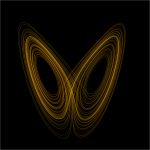In my last post, I ended by suggesting that
Many systems in the world display truly chaotic behavior, wherein small changes to the initial conditions creating vast differences in the outcomes. On the other hand, many have very stable attractors like those described above, where one can discard most of the external factors affecting them in favor of a much smaller number that have the largest effects on the outcome.
Weather is the canonical example of a chaotic system. atmospheric systems are extremely unpredictable, with their behaivior varying greatly depending on small variations of initial conditions. Moreover, weather systems are so immense, and consist of so many
component variables, that even if we could accurately simulate them, collecting the right initial conditions to kick off our simulation would be infeasible as well.
Even so, there are features of weather systems that do make them somewhat tractable – we can recognize and predict the behavior of things like storm fronts, high pressure systems, hurricanes, and jet streams. These behave in relatively stable ways for short periods of time, allowing us to make predictions (though over long enough periods of time, the collective weight of small errors in initial conditions build up and render our models useless).
Similar things may be said about other complicated systems. While it is impossible to perfectly predict the behavior of the U.S. electorate during a national election, with enough samples, sites like FiveThirtyEight.com came within an astonishingly small margin of the final tally in the 2008 presidential election. Again, this result was possible because the electorate behaves in a relatively stable way for a short period of time, even if we cannot measure its initial state 100% accurately.
We can even say the same sort of thing about things like the observable world around us. For instance, on my walk to work, I see an incredibly complex world around me, with cars, people, animals, buildings, rain and snow, and thousands of other events happening
all the time. If I were to freeze-frame a single moment of my walk, and observe the multitude of objects around me, there are millions of possible “next steps” that might happen. That car on the street might swerve violently to the left and hit a parking meter. That woman in front of me might start spinning in circles in the middle of the sidewalk. The lights might change color at random times, without warning.
But none of those things are likely to happen. In fact, if you showed that snapshot of my walk to a dozen people, and asked them what the same scene would look like three seconds hence, they’d probably unanimously agreee on the major features of the scene.
Cars will continue to drive down the road in a predictable way, people will continue to walk straight down the street, lost in their thoughts, and lights will change on a regular timetable. The dozen people might disagree on the details, like what color the next car
that comes down the street might be, but the major components would be the same.
So, the world evolves in a chaotic way where the details are difficult to predict, but the major features tend to evolve in a stable and continuous way when observed at a certain scale of time and space. Sound familiar? These relatively stable features are strange attractors in the complex system of the world. For nearby sets of initial conditions, events in the world fall into a the same basin of attraction. A car driving down the street will most likely continue to drive down the street, regardless of whether it is one inch to the right or left. A person walking will continue to put one foot in front of the other, regardless of whether they step on a crack in the sidewalk or not.
This continuity and predictability on a certain scale is a major feature of the world around us, and one that I believe is intimately related to the way our brains perceive the world. If the world really were chaotic, in the sense that outcomes were extremely sensitive to variation in initial conditions, we wouldn’t be able to make any sense of it. Unless we had extraordinarily sensitive perceptions, each time we perceived something we would miss subtle details in the initial conditions, and the outcome would be so different that we’d never be able to understand the world.
But this isn’t the case. There are millions of possible places that a car that I perceive could be three seconds from now, but my brain can predict with high probability that it won’t be on the sidewalk, so I continue walking. Similarly, despite subtle variations in lighting, angle, and distance, I can consistently recognize a friend’s face each time I see him. The details are different each time, but the overall impression – “That’s my friend” – is the same to my mind.
Our brains are wired in such a way as to mimic these basins of attraction in the world. We do, actually, perceive many subtle variations in our environment, things like lighting, angle, distance, temperature, and smell. To make sense of the world, we look beyond the chaos, and see only the patterns.


